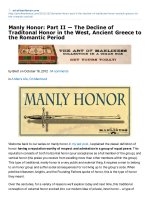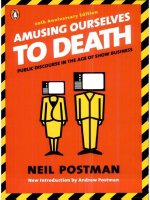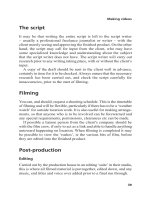In the line of fire~how to handle tough questions when it counts 2005
Bạn đang xem bản rút gọn của tài liệu. Xem và tải ngay bản đầy đủ của tài liệu tại đây (5.1 MB, 217 trang )
Early Praise for In the Line of Fire
“In my role at Cisco Systems, I am confronted with challenging questions
from customers, government leaders, press, and analysts on a daily basis. The
techniques used in this book, In the Line of Fire, are spot on; providing
straightforward ways to be on the offense in all communications situations.”
Sue Bostrom, SVP Internet Business Solutions Group and Worldwide
Government Affairs, Cisco Systems
“In an era where businesspeople and politicians unfortunately have proven
their inability to be honest with bad news, I believe this book should be prescribed reading in every business school, and for every management training session. In fact, I hope it is read by a far wider audience than that. It’s
just what our society needs right now.”
Po Bronson, author of the bestselling What Should I Do With My Life?
“Jerry Weissman tells the tales of the makings of presidents and kings, the
dramas of the dramatic moments of our time, and in each episode he uncovers the simple truths behind what makes great leaders like Ronald Reagan
and Colin Powell loved and trusted. Great truths made simple and compelling for any leader to use.”
Scott Cook, Founding CEO, Intuit
“Jerry’s book is a must-read for any presenter facing tough and challenging
questions from their audience. This book provides the fundamental foundation on how to prepare, be agile, and take charge no matter how difficult
the question.”
Leslie Culbertson, Corporate Vice President Director of Corporate Finance,
Intel Corporation
“During one of the most important periods of my career, Jerry used the concepts in In the Line of Fire to prepare me and my team for the EarthLink IPO
road show. He helped us field tough questions from the toughest possible
audience: potential investors, but the same skills are necessary for every
audience.
Sky Dayton, Founder EarthLink and Boingo Wireless, CEO SK-EarthLink
“Jerry Weissman helped prepare my management team for our recent IPO. I
sat in on some of the sessions and was most impressed with Jerry’s innovative ways of teaching and optimizing effective executive communication
methods. This training, encapsulated well in his new book, In the Line of
Fire,” paid off handsomely during our numerous road show presentations.”
Ray Dolby, Founder and Chairman, Dolby Laboratories, Inc.
“Whether you’re a classroom teacher or the President, this book will help
you be an effective communicator. This book is so insightful, reading it feels
like cheating. Tough questions no longer test my limits.”
Reed Hastings, Founder and CEO, Netflix
“Even the greatest start encounters tough questions. Read Jerry’s book before
you need it, or you’ll be in deep sushi.”
Guy Kawasaki, author of the bestselling The Art of the Start
“Have you ever been faced with a tough question? Jerry Weissman shows
how it’s not necessarily what the answer is. It’s how you answer that will
allow you to prevail and win!”
Tim Koogle, Founding CEO, Yahoo!
“Jerry’s technique is both masterful and universal because it finds common
ground between audience and speaker, hard questions and direct answers,
all with a very simple principle: truth.”
Pierre Omidyar, Founder of eBay and Omidyar Network
“I’ve been asking tough questions for half a century and listening to variously brilliant, boring, evasive or illuminating answers. Jerry Weissman’s
book will help anyone…anyone…answer even the toughest questions.”
Mike Wallace, Senior Correspondent, Sixty Minutes, CBS News
In the Line of Fire
How to Handle
Tough Questions
…When It Counts
In the Line of Fire
How to Handle
To u g h Q u e s t i o n s
…When It Counts
■■■
Jerry Weissman
■■■
Author of
Presenting to Win: The Art of Telling Your Story
An Imprint of Pearson Education
Upper Saddle River, NJ • New York • London • San Francisco • Toronto • Sydney •
Tokyo • Singapore • Hong Kong • Cape Town • Madrid
Paris • Milan • Munich • Amsterdam
Library of Congress Catalog Number: 2005922492
Vice President and Editor-in-Chief: Tim Moore
Acquisitions Editor: Paula Sinnott
Editorial Assistant: Kate E. Stephenson
Development Editor: Russ Hall
International Marketing Manager: Tim Galligan
Cover Designer: Sandra Schroeder
Managing Editor: Gina Kanouse
Senior Project Editor: Lori Lyons
Copy Editor: Christal Andry
Senior Indexer: Cheryl Lenser
Senior Compositor: Gloria Schurick
Art Consultant: Nichole Nears
Video Consultant: Jennifer Turcotte
Manufacturing Buyer: Dan Uhrig
©2005 by Pearson Education, Inc.
Publishing as Prentice Hall
Upper Saddle River, New Jersey 07458
Prentice Hall offers excellent discounts on this book when ordered in quantity for
bulk purchases or special sales. For more information, please contact U.S. Corporate
and Government Sales, 1-800-382-3419, For sales
outside the U.S., please contact International Sales, 1-317-581-3793,
Company and product names mentioned herein are the trademarks or registered trademarks
of their respective owners.
WIIFY, Point B, Eye Connect, and Topspin and service marks or registered service marks of
Power Presentations, Ltd., © 1988-2005.
Courtesies: CNN; ABC News Video Source
“THE BOB NEWHART SHOW” ©1975, Twentieth Century Fox Television. Written by Bruce Kane.
All rights reserved.
©2004 Gallup Organization. All rights reserved. Reprinted with permission from www.gallup.com.
All rights reserved. No part of this book may be reproduced, in any form or by any means,
without permission in writing from the publisher.
Printed in the United States of America
First Printing: June 2005
ISBN 0-13-185517-4
Pearson
Pearson
Pearson
Pearson
Pearson
Pearson
Pearson
Pearson
Education LTD.
Education Australia PTY, Limited.
Education Singapore, Pte. Ltd.
Education North Asia, Ltd.
Education Canada, Ltd.
Educatio[ac]n de Mexico, S.A. de C.V.
Education—Japan
Education Malaysia, Pte. Ltd.
For Lucie…at last.
CONTENTS
■■■
Introduction: Agility versus Force
xv
Challenging Questions • Martial Arts • Effective
Management Perceived • Baptism under Fire
Case Studies: Bill Clinton; David versus Goliath;
Bruce Lee; David Bellet; Mike Wallace
■■■
Chapter One: The Critical
Dynamics of Q&A
1
Defensive, Evasive, or Contentious • Presenter
Behavior/Audience Perception
Case Studies: The Classic Bob Newhart Episode;
Trent Lott on Black Entertainment Television;
Pedro Martinez; The NAFTA Debate; Two Weeks
of an IPO Road show
■■■
Chapter Two: Effective Management
Implemented
15
Worst Case Scenario • Maximum Control in
Groups • The Q&A Cycle • How to Lose Your
Audience in Five Seconds Flat
■■■
Chapter Three: You’re Not listening!
Case Studies: 1992, 2000, and 2004 U.S.
Presidential Debates
■
IX
■
23
CONTENTS
■■■
Chapter Four: Active Listening
39
(Martial Art: Concentration)
• The Roman Column • Sub-vocalization •
Visual Listening • … You Still Don’t Understand
• Yards After Catch
Case Study: 1992 U.S. Presidential Debate in
Retrospect
■■■
Chapter Five: Retake the Floor
53
(Martial Art: Self-defense)
Paraphrase • Challenging Questions • The Buffer
• Key Words • The Double Buffer • The Power
of “You” • The Triple Fail-Safe
Case Study: Colin Powell
■■■
Chapter Six: Provide the Answer
(Martial Art: Balance)
81
Quid Pro Quo • Manage the Answer • Anticipate
• Recognize the Universal Issues • How to
Handle Special Questions • Guilty as Charged
Questions • Point B and WIIFY • Topspin •
Media Sound Bites
Case Studies: George W. Bush; John F. Kerry;
George H. Bush Revisited
■■■
Chapter Seven: Topspin in Action
(Martial Art: Agility)
Michael Dukakis Misses a Free Kick •
The Evolution of George W. Bush • Lloyd Bentsen
Topspins • Ronald Reagan Topspins
■
X
■
97
CONTENTS
■■■
Chapter Eight: Preparation
115
(Martial Art: Discipline)
Lessons Learned
Case Studies: John F. Kennedy versus Richard M.
Nixon, Al Gore versus Ross Perot
■■■
Chapter Nine: The Art of War
125
(Martial Art: Self-Control)
The Art of Agility • Force: 1992 • Agility: 1996 •
Agility and Force: 2000 • Agility and Force: 2004
• The Critical Impact of Debates • Lessons
Learned
Case Studies: Al Gore debates Dan Quayle, Jack
Kemp, and George W. Bush; George W. Bush
debates John F. Kerry; The Presidential Debates:
1960 through 2004
■■■
Chapter Ten: The Role Model
157
Complete Control
Case Study: General Norman Schwarzkopf
Endnotes
169
Acknowledgments
175
Index
179
■
XI
■
About the Author
Jerry Weissman, the world’s #1 corporate presentations coach,
founded and leads Power Presentations, Ltd. in Foster City, CA.
His private clients include executives at hundreds of the world’s
top companies, including Yahoo!, Intel, Cisco Systems, Intuit,
Dolby Laboratories, and Microsoft.
Weissman coached Cisco’s executives before their immensely
successful IPO roadshow; afterward, the firm’s chairman
attributed at least two to three dollars of Cisco’s offering price to
his work. Since then, he has prepared executives for nearly 500
IPO roadshows, helping them raise hundreds of billions of
dollars.
Weissman is author of the global best-seller Presenting to Win:
The Art of Telling Your Story (Financial Times Prentice Hall, 2003).
■
XIII
■
INTRODUCTION
INTRODUCTION
Agility Versus Force
During my 40 years in the communications trade ranging from the
control rooms of the CBS Broadcast Center in Manhattan to the
boardrooms of some of America’s most prestigious corporations,
I have heard…and have asked…some highly challenging
questions. One of the most challenging I ever heard came during
Bill Clinton’s presidency when he was engulfed in the firestorm
ignited by the revelation of his extramarital affair with Monica
Lewinsky, a White House intern.
Despite intense public and media pressure, Clinton continued to
fulfill his presidential obligations, among them hosting a state visit
by the Prime Minister of the United Kingdom, Tony Blair. On the
afternoon of February 6, 1998, after the two heads of state made
their customary prepared statements to the press, President
Clinton opened the floor to questions from an audience packed
with reporters. At that point, he became fair game for nonstate
questions on the subject that was uppermost in the minds of the
media and the public. One question in particular came from Wolf
Blitzer, the senior CNN political correspondent:
Mr. President, Monica Lewinsky’s life has been changed
forever, her family’s life has been changed forever. I
wonder how you feel about that and what, if anything,
you’d like to say to Monica Lewinsky at this minute?
The stinging question brought a few scattered titters from the
other reporters. Looking straight ahead, right at Blitzer, Clinton
■
XV
■
IN THE LINE OF FIRE
smiled and bit his lower lip, an expression that had become his
trademark (see Figure I.1).
▲ FIGURE I.1
Bill Clinton reacts to a question about Monica Lewinsky.
Then he said,
That’s good!
The crowded room erupted in laughter. After it subsided, Clinton
continued:
That’s good…but at this minute, I am going to stick with
my position and not comment. [I.1]
Blitzer had nailed the acknowledged charismatic master of
communication skills at his own game, and the master
acknowledged it publicly for all to hear. Fortunately for Clinton,
he was able to default to his legal situation and not answer.
Very few people on the face of this planet have the expertise, the
charm, the quickness of wit, or the legal circumstances to respond
■
XVI
■
INTRODUCTION
so deftly to challenging questions. Yet very few people on the
face of this planet sail through life without being confronted with
tough questions. The purpose of this book and its many real-life
examples is to provide you with the skills to handle such
questions, and only such questions. If all the questions you are
ever faced with were of the “Where do I sign?” variety, you could
spend your time with a good mystery novel instead. Forewarned
is forearmed.
One other forewarning: All the techniques you are about to learn
require absolute truth. The operative word in the paragraph
above, as well as on the cover of this book, is “handle,” meaning
how to deal with tough questions. While providing an answer is
an integral part of that “handling,” every answer you give to every
question you get must be honest and straightforward. If not, all
the other techniques will be for naught. With a truthful answer as
your foundation, all those techniques will enable you to survive,
if not prevail, in the line of fire.
■■■
Challenging Questions
We begin our journey of discovery by understanding why people
ask challenging questions. Journalists such as Wolf Blitzer ask
these kinds of questions because, being familiar with the classical
art of drama, they know that conflict creates drama. Aristotle 101.
Why do people in business ask challenging questions? Because
they are mean-spirited? Perhaps. Because they want to test your
mettle? Perhaps. More likely it is because when you are presenting
your case, which is just the case in almost every decisive
communication in business…as well as in all walks of life…you
are asking your opposite party or parties, your target audience, to
change. Most human beings are resistant to change, and so they
kick the tires. You are the tires.
■
XVII
■
IN THE LINE OF FIRE
In the most mission-critical of all business presentations, the Initial
Public Offering (IPO) road show…a form of communication I
have had the opportunity and privilege to influence with nearly
500 companies, among them Cisco Systems, Intuit, Yahoo!, and
Dolby Laboratories…presenters ask their investor audiences to
change: to buy a stock that never existed. In fact, when
companies offer shares to the public for the first time, the U.S.
Securities and Exchange Commission mandates that the
companies specifically state their intentions in print. The SEC
requires distribution of a prospectus containing a boilerplate
sentence that reads, “There has been no prior public market for
the company’s common stock.” In other words, “Invest at your
own risk.” Caveat emptor. As a result, when the companies’
executive teams take their presentations on the road, they are
inevitably assaulted with challenging questions from their
potential investors.
While the stakes in an IPO road show are exceedingly high…in
the tens of millions of dollars…the character of the challenge is
no different from that of potential customers considering a new
product, potential partners considering a strategic relationship,
pressured managers considering a request for additional
expenditures, concerned citizens considering a dark horse
candidate, or even affluent contributors considering a donation to
a nascent, not-for-profit cause.
The inherent challenge in these circumstances is compounded in
presentation settings where the intensity level is raised by several
additional factors:
■
Public exposure. The risk of a mistake is magnified in large
groups.
Group dynamics. The more people in the audience, the more
difficult it is to maintain control.
■
■
One against many. Audiences have an affinity bond among
themselves and apart from the presenter or speaker.
■
XVIII
■
INTRODUCTION
The result is open season on the lone figure spotlighted at the
front of the room, who then becomes fair game for a volley of
even more challenging questions.
How, then, to level the playing field? How, then, to give the
presenter the weapons to withstand the attack? How, then, to
survive the slings and arrows unleashed in the form of questions?
The answer lies in the David versus Goliath match, in which a
mere youth was able to defeat a mighty giant using only a stone
from a slingshot. This biblical parable has numerous equivalents
in military warfare. History abounds with examples in which
small, outnumbered, under-equipped units were able to combat
vastly superior forces by using adroit
maneuvers and clever defenses.
Use agility to counter force.
Remember the Alamo, but also
remember Thermopylae, Masada,
Agincourt, The Bastille, Stalingrad, The
Battle of the Bulge, Iwo Jima, and The Six-Day War. All these
legendary battles share one common denominator: leverage, or
the use of agility to counter force.
■■■
Martial Arts
For our purposes, the most pertinent modern equivalent is the
martial arts, in which a skilled practitioner can compete with a
superior opponent by using dexterity rather than might. Bruce
Lee, a diminutive kick boxer, became an international star by
virtue of his uncanny ability to prevail over multiple and mightier
armed opponents using only his flying feet and hands. Evolved
from Asian philosophy and religion, the martial arts employ these
critical mental and physical skills:
■
Concentration
■
Self-defense
■
XIX
■
IN THE LINE OF FIRE
■
Balance
■
Agility
■
Discipline
■
Self-control
A solitary presenter or speaker facing challenging questions from
a hostile audience can deploy these same pivotal dynamics
against a sea of troubles and, by opposing, end them. This book
will translate each of these martial arts skills into Q&A techniques
and then demonstrate how you can apply them in your missioncritical encounters. The objective is to put you in charge of those
sessions and enable you to win in your exchanges when it counts.
This objective can be stated in one word, although it will take 168
pages to present them in full. That one word is control. When
you are confronted with tough questions, you can control
■
The question
■
Your answer
■
The questioner
■
The audience
■
The time
■
Yourself
■■■
Effective Management Perceived
A synonym for the verb “control” is “manage.” Therefore, the
subliminal perception of a well-handled question is Effective
Management. Of course, no one in your target audience is going
to conclude that because you fielded a tough question well, you
are a good manager. That is a bit of a stretch. But the converse
proves the point. If your response to a challenging question is
defensive, evasive, or contentious, you lose credibility…and with
it the likelihood of attaining your objective in the interchange.
■
XX
■
INTRODUCTION
If your response is prompt, assured, and to the point, you will be
far more likely to emerge unscathed, if not fully victorious.
This concept goes all the way back to the first millennium. In
Beowulf, the heroic saga that is one of the foundation works of
the English language, one of the lines reads: “Behavior that’s
admired is the path to power among people everywhere.” [I.2]
In the twenty-first century, that same concept as it relates to tough
questions was expressed by David Bellet, the Chairman of Crown
Advisors International, one of Wall Street’s most successful longterm investment firms. Having been an early backer of many
successful companies, among them Hewlett-Packard, Sony, and
Intel, David is solicited to invest almost daily. In response, he
often fires challenging questions at his petitioners.
“When I ask questions,” says David, “I don’t really have to have
the full answer because I can’t know the subject as well as the
presenter. What I look for is whether the presenter has thought
about the question, been candid, thorough, and direct and how
the presenter handles himself or herself under stress; if that
person has the passion of ‘fire in the belly’ and can stand tall in
the line of fire.”
■■■
Baptism Under Fire
I, too, was once in the business of asking tough questions. Before
becoming a presentation coach for those nearly 500 IPO road
shows, as well as for thousands of other presentations ranging
from raising private capital to launching products, seeking
partnerships, and requisitioning budget approvals, I spent a
decade as a news and public affairs producer at CBS Television in
New York. As a student of the classical art of drama and with the
full knowledge that conflict creates drama, I became an expert at
asking challenging questions.
■
XXI
■
IN THE LINE OF FIRE
My baptism under fire came early in my tenure at CBS. In 1963, I
was assigned to be the Associate Producer of a documentary
series called Eye on New York, whose host was the then newly
hired Mike Wallace. Although Sixty Minutes, Mike’s magnum
opus, would not debut for another five years, he came to CBS
largely on the strength of the reputation he had developed on
another New York television station as an aggressive interrogator
on a series called Night Beat. Mike had regularly bombarded his
Night Beat guests with tough questions and was intent on
maintaining his inquisitorial reputation at CBS. He fully expected
his Associate Producer to provide him with live ammunition for
his firepower. Heaven help me when I did not.
Fortunately, I survived Mike’s slings and arrows by learning how
to devise tough questions. In the process, I also learned how to
handle those same questions. This book is a compilation of those
techniques, seasoned and battle-tested for nearly 20 years in
business with my corporate clients.
You will find the techniques illustrated with a host of examples
from the business world, as well as from the white-hot cauldron of
debate in the political world.* In that world…unlike business and
other areas of persuasive endeavor where facts and logic are at
stake…the issue is a contest of individuals pitted one against the
other in mortal combat: Only the winner survives. Although the
lone presenter or speaker pitted against the challenging forces of
an audience is not quite as lethal as politics, the one-against-many
odds raise the stakes. Therefore, analyzing the dynamics of
political debate will serve as a tried and tested role model for your
Q&A skills. The following pages will provide you with an arsenal
of weapons you will need when you step into the line of fire.
Expanding upon David Bellet’s observation, the objective of this
book is not so much to show you how to respond with the right
answers as it is to show you how to establish a positive perception
with your audiences by giving them the confidence that you can
manage adversity, stay the course, and stay in control.
*For a companion DVD of the original videos of these examples, please visit
www.powerltd.com.
■
XXII
■
CHAPTER
1
The Critical
Dynamics
of Q&A
1
IN THE LINE OF FIRE
To fully appreciate the importance of control in handling tough
questions, we should first look at the consequences of loss of
control. A vivid example of such a disastrous unraveling comes
from an episode of the 1970s comedy television series, The Bob
Newhart Show. The widely known series is still running in
syndication. One particular episode has become a classic. In it,
Newhart plays a psychologist named Robert Hartley, who amiably
agrees to appear on a Chicago television program to be
interviewed by Ruth Corley, the program’s hostess. This is the
interview:
Ruth Corley: Good morning, Dr. Hartley. Thank you
for coming. I hope it’s not too early for you.
Dr. Hartley: No, I had to get up to be on television.
Ruth Corley: Well, I’m glad you’re relaxed. I’m a little
nervous myself, I mean, I’ve never interviewed a
psychologist.
Dr. Hartley: Don’t worry about it; we’re ordinary men
you know, one leg at a time.
Ruth Corley: Well, if I start to ramble a little or if I get
into an area I’m not too conversant with, you’ll help me
out, won’t you?
Dr. Hartley: Don’t worry about it. If you get into
trouble, just turn it over to me and I’ll wing it.
Augie (Voice Over): 10 seconds, Ruth!
Ruth Corley: Thanks, Augie.
Dr. Hartley: You’ll be fine.
Ruth Corley: Here goes.
Augie (VO): 3, 2, you’re on.
Ruth Corley: Good morning. It’s 7 o’clock, and I am
Ruth Corley. My first guest is psychologist, Dr. Robert
Hartley. It’s been said that today’s psychologist is nothing
■
2
■









